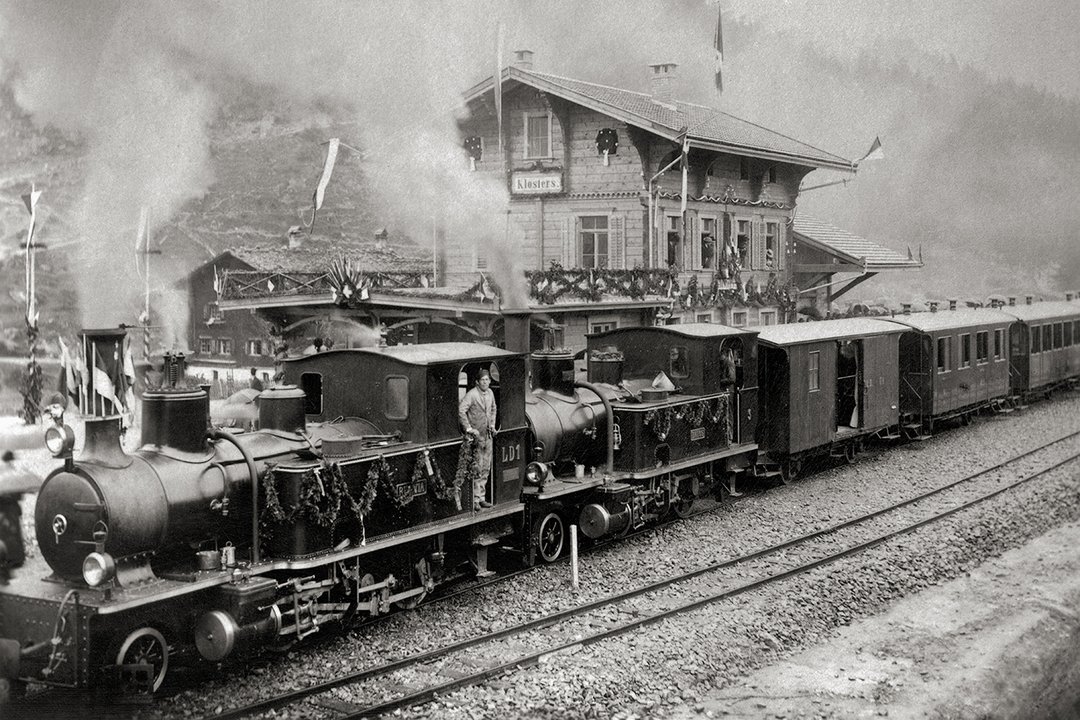Warenkorb
Sie haben keine Produkte im Warenkorb.
Les contenus ne sont pas tous disponibles dans la langue choisie. Désirez-vous découvrir le monde de la Rhätische Bahn dans son ensemble? anglais
With our unique mountain routes, UNESCO World Heritage status, as well as the Glacier Express and Bernina Express lines, we have been providing fascinating rail travel experiences throughout the Swiss canton of Graubünden since 1889. It is now impossible to imagine this region - one of the most beautiful in Switzerland - without our world-famous railway. What began in 1889 with the opening of the line from Landquart to Klosters, has become a 385-kilometre network set amidst mountainous terrain. Harmoniously embedded in the natural landscape, the rail lines and engineering structures all add to the charm of the Swiss canton of Graubünden.
In 1888, railway pioneers from the Graubünden area brought to fruition their idea of building a mountain railway. Back then, thanks to the initiative of Dutchman Willem-Jan Holsboer, they founded the Schmalspurbahn Landquart–Davos AG, a narrow-gauge railway company. The ground-breaking ceremony took place that same year, and the Landquart – Klosters railway line opened in 1889. The first steam trains began plying the route from Landquart to Davos in 1890. Lines to St. Moritz, Disentis and Scuol-Tarasp followed later. The mergers with the Arosa and Bernina railway companies expanded the Rhaetian Railway's network of lines.

A mere quarter of a century later, the entire Rhaetian Railway rail network was nearing completion. In 1999 the Vereina Tunnel was opened as the last extension to the network. While Rhaetian Railway has continued to develop, it has remained true to the spirit of those early years in one thing: it links the most beautiful locations in the mountain regions through fascinating railway lines.
| 1889 | The Landquart-Davos Smalspurbahn (LD Narrow-Gauge Railway Company) opens the Landquart – Klosters line |
| 1890 | Klosters – Davos line opens |
| 1895 | LD changes its name to «Rhaetian Railway» |
| 1896 | Landquart – Thusis line opens |
| 1903 | Reichenau – Ilanz line opens |
| 1904 | Thusis – St. Moritz line opens |
| 1907 | Bellinzona – Mesocco line opens |
| 1908 | Samedan – Pontresina line opens |
| 1909 | Davos – Filisur line opens |
| 1910 | St. Moritz – Tirano line opens (Berninabahn Railway Company) |
| 1912 | The first electric engine is procured; Ilanz - Disentis/Mustér line opens |
| 1913 | Bever – Scuol-Tarasp line opens |
| 1914 | Chur – Arosa line opens (Chur-Arosa Bahn Railway Company) |
| 1922 | Electrification of the RhB is completed |
| 1930 | Inaugural run of the Glacier Express from St. Moritz to Zermatt |
| 1942 | RhB merges with the Chur-Arosa Bahn Railway Company; RhB merges with the Bellinzona-Mesocco Bahn Railway Company |
| 1943 | RhB merges with the Berninabahn Railway Company |
| 1973 | Inauguration of the Bernina Express |
| 1979 | Twinning agreement with Hakone Tozan Railway (Japan) |
| 1982 | Furka Base Tunnel opens (year-round Glacier Express service) |
| 1989 | RhB celebrates its centenary. To mark the occasion, the RhB adopts a new corporate image and repaints its trains in a new red livery |
| 1997 | The electrified Chur – Arosa line is converted from 2,400V DC to 11,000V AC |
| 1999 | Klosters – Lavin/Susch line opens (Vereina Tunnel with car transporter) - the first extension to the network since 1914 |
| 2003 | Bellinzona – Mesocco line closes |
| 2008 | The Albula and Bernina Lines are added to the UNESCO World Heritage List |